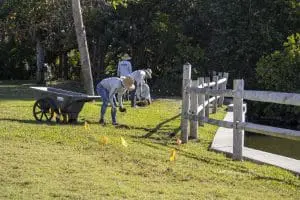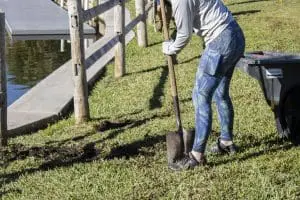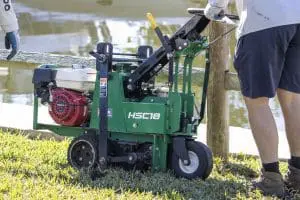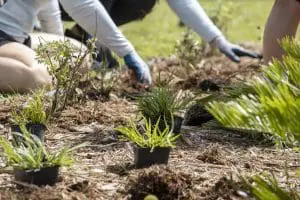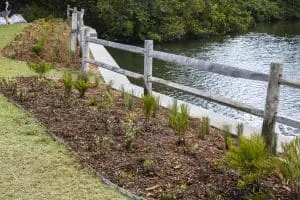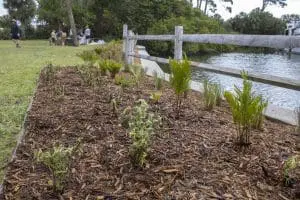

Our Restore Our Shores (ROS) team was out of the Indian River Lagoon (but not too far away!) for their latest project to help bring this important body of water back to health: buffer zones! Our ROS team’s first buffer zone was planted at Oars and Paddles Park in the Town of Indian Harbor Beach.
This project was funded by the Doris M. Carter Family Foundation, an environmentally conscious foundation focused on restoring Florida’s natural beauty for today and the future. Thank you!
Buffer zones protect sensitive areas like the Indian River Lagoon by establishing a native plant garden between the body of water and potential nutrient pollution. Our team planted native vegetation between the park’s non-native St. Augustine grass lawn and the lagoon. This created a “no-mow” and “no-fertilizer” zone along the lagoon.
“Excessive freshwater, fertilizer and lawn clippings that wash off traditional lawns into the lagoon degrade water quality by increasing nutrient concentrations that fuel algae blooms,” said Olivia Escandell, conservation manager with ROS.
There are a number of benefits to establishing buffer zones along the lagoon using native plants. Once established, these plants do not require extra water, fertilizer, or excessive trimming. Their deeper roots can also prevent erosion more effectively.
Using native grasses, flowers and palms also provides habitat and forage for local wildlife as well. Bees and butterflies will feed on the flowers and leaves of plants while small mammals and birds will use the grasses and palms for nesting and feed on the plants’ berries and new growth shoots.
Mangroves are often planted along the shoreline to create habitat for wildlife and protection against erosion, among other benefits. The tall seawall at this site made adding mangroves not possible, however.
“Buffer zone plantings are actually a great way to add native plants along the lagoon in areas where mangroves will not survive,” Olivia said. “These plantings give us another shoreline restoration option in our tool kit.”
Our ROS team will continue to water and monitor the site, while the Indian Harbor Beach public works department will help maintain the planting past establishment by mulching and weeding. We look forward to adding buffer zones to future restoration projects!
Interested in native plants? Our ROS team used muhly grass, dwarf fakahatchee grass, saw palmetto, coontie palm, butterfly milkweed, blue eyed grass, dune sunflower, blanket flower and firebush.
Interested in creating your own buffer zone? Even if you have mangroves along your shoreline, adding native plants like grasses, flowers, and palms behind your mangroves can add more habitat and nutrient removal benefits as long as they are salt tolerant.
- Remove at least a 10-foot buffer of turf grass from along your seawall. Place cardboard on the ground as a weed blocker, and then add 3-4 inches of mulch on top of the cardboard. Leave the buffer zone as mulch only for at least one month.
- Plan out your design and source plants from local nurseries (visit floridalivingshorelines.org, fnps.org, or https://gardeningsolutions.ifas.ufl.edu/ to find what plants will thrive in your area).
- Make sure to dig through the mulch and cardboard layer until you reach the soil to plant your plants. Water 3-5 times a week for the first couple of weeks to help plants establish. Weed, re-mulch and trim plants as necessary (make sure trimmings do not end up in the lagoon but go into your compost or yard waste bin!).
Brevard Zoo is an independent, not-for-profit organization that receives no recurring government funding for our operating costs. Your generous support enables us to continue to serve our community and continue our vital animal wellness, education and conservation programs.


